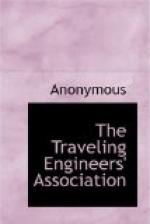A. Would cause the release of the brakes on the head end of the train.
95. Q. What will cause air to blow at the brake pipe exhaust port when the handle is moved to lap position?
A. This is caused by a leak from the equalizing reservoir or its connections, which reduces the pressure in chamber “D” above the equalizing piston, allowing brake pipe pressure under the piston to force it up, unseating the brake pipe exhaust valve, permitting brake pipe air to flow to the atmosphere.
96. Q. What is the purpose of the equalizing reservoir?
A. The purpose of the equalizing reservoir is to furnish a larger volume of air above the equalizing piston than is found in chamber “D”, thus to enable the engineer to make a graduated reduction of the pressure above the equalizing piston.
97. Q. What defect will cause the brake pipe and main reservoir pressure to equalize when the handle is in running position?
A. This may be caused by leakage past the rotary valve, defective body gasket, or leakage by the feed valve or its case gasket. To determine which part is at fault, close the cut-out cock under the brake valve and move the handle to service position, exhausting all air from chamber “D” and the brake pipe; return the handle to lap position. Leakage of air past the rotary valve is generally into the brake pipe port which allows the air to come in under the equalizing piston, thus forcing it upward, unseating the brake pipe exhaust valve, allowing this air to escape to the atmosphere at the brake pipe exhaust port. Leakage past the body gasket allows air to enter chamber “D”, above the equalizing piston, holding it in its lower position, keeping the brake pipe exhaust port closed, thereby preventing the escape of this air to the atmosphere. Since the capacity of the equalizing reservoir and chamber “D” is small, such a leak will cause the black hand to quickly move up to the position of the red hand. To determine if the leakage be in the feed valve or its gasket, recharge the brake pipe to some pressure below the adjustment of the feed valve, then place the handle in lap position. If the black hand on the air gauge remains stationary, it is fair to assume that the trouble is in the feed valve or its gasket, as in this position of the brake valve the feed valve is cut out.
98. Q. With the engine alone, the brake pipe pressure will equalize with that in the main reservoir, while when coupled to a train the pressure will remain at that for which the feed valve is adjusted; where is the trouble?
A. This is caused by light leakage of main reservoir air into the brake pipe, and may come past the rotary valve, body gasket, or feed valve, and with the lone engine is sufficient to raise the brake pipe pressure to that in the main reservoir; while, when coupled to a train, the brake pipe leakage of which is greater than this amount, this leakage will not be noticed.




